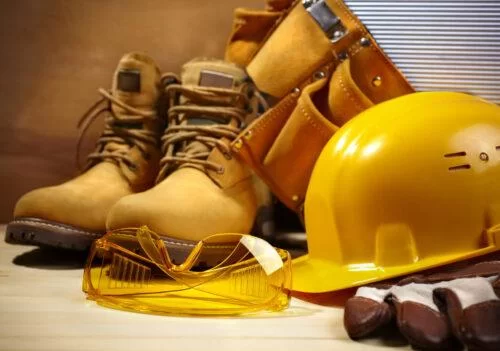No products in the basket.

While working on a construction site, there are many risks and dangers faced by anyone exposed to them. This blog will cover some common construction site Health & Safety risks and what courses are available to improve each area’s risk management.
The most significant risk of working at a height is falling from that height. However, those on the ground level are also at risk from potential objects falling from this height. All falls from height can be dangerous, and the higher the fall, the greater the danger becomes. To help prevent this, the Working at Height course will give workers a better understanding of how to work in these conditions safely. In contrast, those on the ground wouldn’t work within specified exclusion zones and would wear appropriate PPE.
A Course to help with Working at Height
This course is delivered to the CITB standards for assured courses. The purpose of this course is to develop the candidate’s knowledge of the requirements of working at heights regulations so they can assess the relevant risk within their working environment and select the most appropriate equipment as per their organisations’ safe systems of work. The course will also provide knowledge on how to identify industry-wide issues and report these accordingly. The Working at Height Awareness in Construction course is suitable for Managers, Supervisors and Operatives who may be required to work below, at or above ground level.
Construction sites can have hazardous noise levels with varying loud noises depending on the work location (indoors, outdoors, or both) and the stage you’re at within the project. Many activities on a construction site can cause excessive noise, and the use of powered tools and machinery can create dangerous levels of noise; this may cause permanent damage to workers’ ears. However, it is fairly easy to avoid the dangers of loud noises. We can implement primary controls to mitigate the risk to workers and the public by combating the threat at the source. For example, you could set up hearing protection zones and use earplugs or sound-dampening earmuffs; this can significantly reduce the damage to the worker’s ears. However, despite all the prevention, workers should still take regular breaks away from loud noise.
A course to help with noise at work
Control of Noise at Work – (Noise at Work Training Course) is designed for Operatives, Supervisors or Managers who may encounter or need to control unacceptable noise levels in the workplace. This also applies to those who need familiarisation or refresher skills with the relevant standards and legislation
While working on-site, there can be a lot of dangers that cover the floor; these range from trailing cables, poorly stored/discarded materials or holes that can cause trips and falls. Most trips and falls aren’t dangerous; however, the sheer amount of little trips and fall hazards on-site can cause bigger issues. For example, the trip or fall can be even more serious if someone is carrying materials or tools. The best cause of action is to ensure some clear pathways or areas are free of trip hazards to allow safe movement around the site.
A Course to help with Trip & Fall Hazards
CITB Health & Safety Awareness – HSA – This one-day health and safety awareness (HSA) course is designed to aid the understanding of hazards the construction worker may face on site.
It provides a practical summary of health, safety, welfare and environmental issues. It explains the delegate’s responsibilities for looking after themselves and others and outlines the employer’s duties. It also explains what should be done if the worker thinks that anyone’s health and safety are at risk.
Airborne fibres and particles are found on all construction sites. However, their severity depends on what material the particles originate from. Lead & Asbestos are 2 particles that we need to be protected against, failure to do this can cause health implications later on in life or even death. Although most of these fibres and particles can be blocked by a correctly fitted mask. These masks can filter out most, if not all of the dangerous particles.
A Course to help with Airborne Fibres & Particles
Face Fit Testing – This is a classroom-based Toolbox talk with practical group participation on the pre-use fit check of the delegate’s own RPE used within the workplace, individual sensitivity test and fit test will be conducted for each type, make or model of single-use or half mask the employer provides the wearer.
Manual handling is probably the lowest-risk activity that consists of workers moving objects manually from one place to another. The only danger of this is either not lifting using the valid kinetic lifting technique or lifting something above your own capacity. Developing musculoskeletal injuries are easily avoided by learning the correct lifting techniques, this can be done by attending the Manual Handling course.
A Course to help with Manual Handling
This Manual Handling Training course is for anyone who is involved in manual handling within the workplace. This includes the transporting of loads of items by lifting, putting down, pushing, pulling, carrying or moving by hand or by bodily force. This isn’t limited to but includes professions such as construction/building site workers, warehouse and factory staff, heavy manual labourers, unloading and loading of vehicles, office workers and delivery drivers etc.